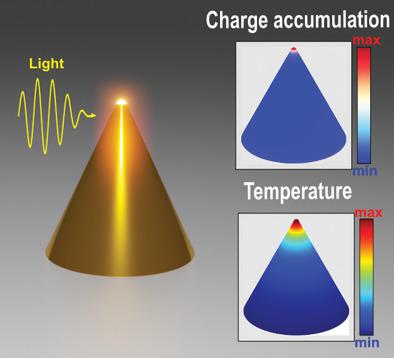当前位置:
X-MOL 学术
›
Adv. Opt. Mater.
›
论文详情
Our official English website, www.x-mol.net, welcomes your feedback! (Note: you will need to create a separate account there.)
Photoinduced Temperature Gradients in Sub‐Wavelength Plasmonic Structures: The Thermoplasmonics of Nanocones
Advanced Optical Materials ( IF 9 ) Pub Date : 2020-06-17 , DOI: 10.1002/adom.202000568 Joao Cunha 1, 2 , Tian‐Long Guo 1 , Alemayehu Nana Koya 3 , Andrea Toma 3 , Mirko Prato 3 , Giuseppe Della Valle 4, 5 , Alessandro Alabastri 6 , Remo Proietti Zaccaria 1, 3
Advanced Optical Materials ( IF 9 ) Pub Date : 2020-06-17 , DOI: 10.1002/adom.202000568 Joao Cunha 1, 2 , Tian‐Long Guo 1 , Alemayehu Nana Koya 3 , Andrea Toma 3 , Mirko Prato 3 , Giuseppe Della Valle 4, 5 , Alessandro Alabastri 6 , Remo Proietti Zaccaria 1, 3
Affiliation

|
Plasmonic structures are renowned for their capability to efficiently convert light into heat at the nanoscale. However, despite the possibility to generate deep sub‐wavelength electromagnetic hot spots, the formation of extremely localized thermal hot spots is an open challenge of research, simply because of the diffusive spread of heat along the whole metallic nanostructure. Here this challenge is tackled by exploiting single gold nanocones. It is theoretically shown how these structures can indeed realize extremely high temperature gradients within the metal, leading to deep sub‐wavelength thermal hot spots, owing to their capability of concentrating light at the apex under resonant conditions even under continuous wave illumination. A 3D finite element method model is employed to study the electromagnetic field in the structure and subsequent thermoplasmonic behavior, in terms of the 3D temperature distribution. How the latter is affected by nanocone size, shape, and composition of the surrounding environment is shown. Finally, the use of photoinduced temperature gradients in nanocones is anticipated for applications in optofluidics and thermoelectrics or for thermally induced nanofabrication.
中文翻译:

亚波长等离子体结构中的光致温度梯度:纳米锥的热等离子体。
等离子结构以其将纳米级的光有效转化为热量的能力而闻名。然而,尽管有可能产生深的亚波长电磁热点,但仅由于热量沿整个金属纳米结构的扩散扩散,形成极局部的热点仍是研究的挑战。在这里,通过开发单个金纳米锥解决了这一挑战。从理论上讲,由于这些结构即使在连续波照明下也能在共振条件下将光聚集在顶点,因此这些结构实际上如何在金属内实现极高的温度梯度,从而导致深亚波长的热点。根据3D温度分布,使用3D有限元方法模型研究结构中的电磁场和随后的热等离子体行为。显示了后者如何受到纳米锥尺寸,形状和周围环境组成的影响。最后,预期将光致温度梯度用于纳米锥中可用于光流学和热电学或用于热诱导纳米加工。
更新日期:2020-06-17
中文翻译:

亚波长等离子体结构中的光致温度梯度:纳米锥的热等离子体。
等离子结构以其将纳米级的光有效转化为热量的能力而闻名。然而,尽管有可能产生深的亚波长电磁热点,但仅由于热量沿整个金属纳米结构的扩散扩散,形成极局部的热点仍是研究的挑战。在这里,通过开发单个金纳米锥解决了这一挑战。从理论上讲,由于这些结构即使在连续波照明下也能在共振条件下将光聚集在顶点,因此这些结构实际上如何在金属内实现极高的温度梯度,从而导致深亚波长的热点。根据3D温度分布,使用3D有限元方法模型研究结构中的电磁场和随后的热等离子体行为。显示了后者如何受到纳米锥尺寸,形状和周围环境组成的影响。最后,预期将光致温度梯度用于纳米锥中可用于光流学和热电学或用于热诱导纳米加工。



























 京公网安备 11010802027423号
京公网安备 11010802027423号